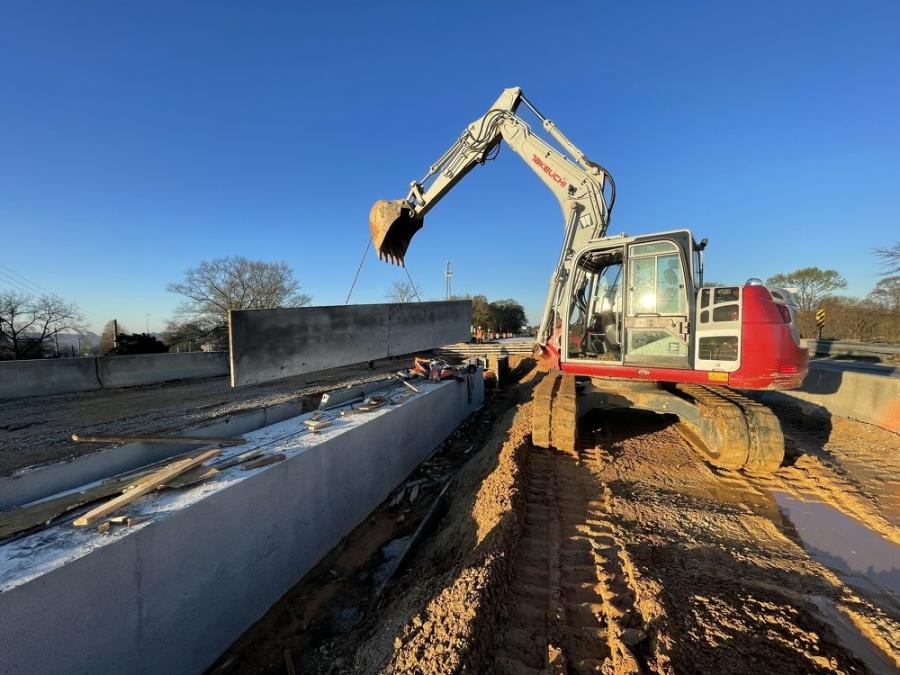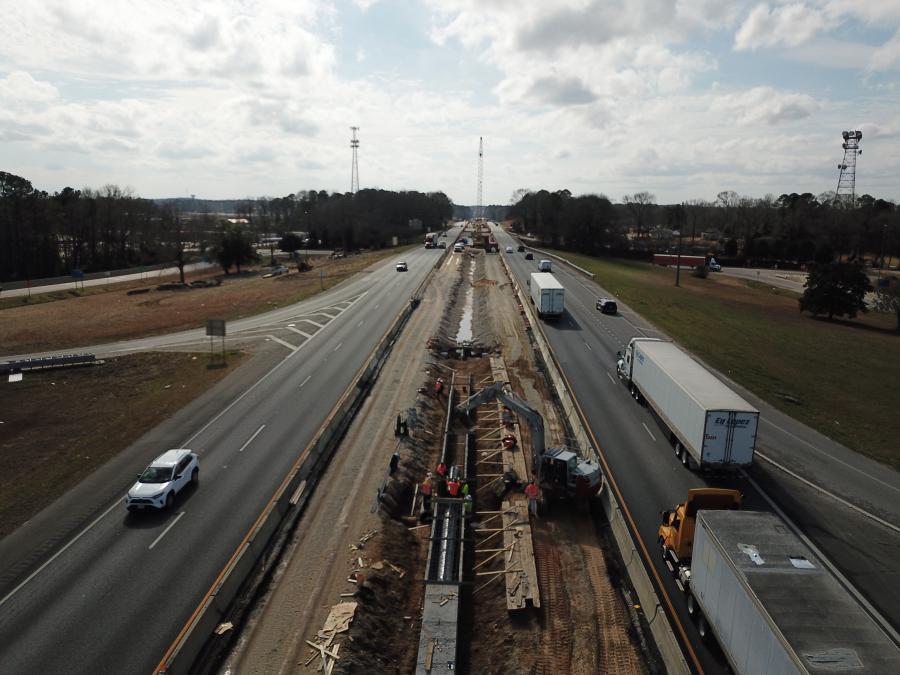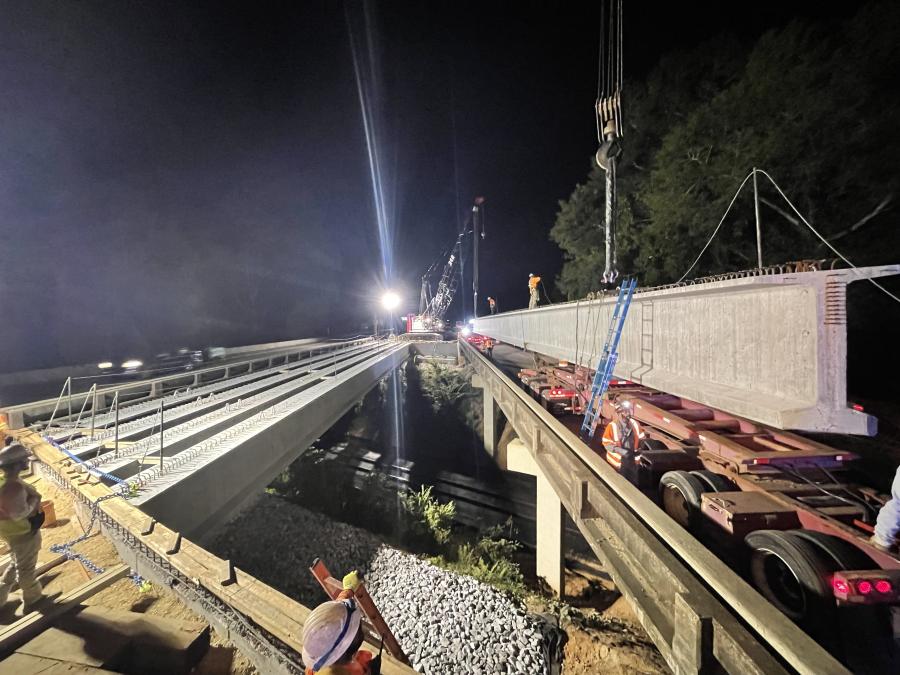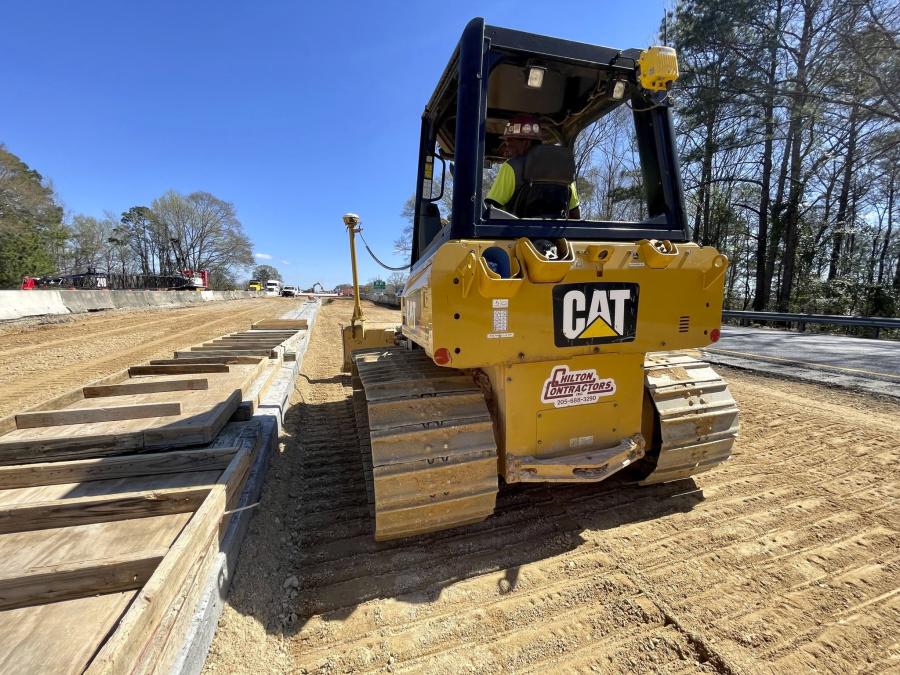To date, the project is just over a third complete. The contract has 510 working days.
(Caleb Tyler photo)
In southeast Alabama, crews are working on a $32 million project that will replace six functionally obsolete bridges along Interstate 85 at exit 60.
The structures are being replaced due to their narrow width and age, with the Alabama Department of Transportation (ALDOT) overseeing the work.
"The bridges over Long Street, the Norfolk Southern Railroad and Alabama Highway 51 (Marvyn Parkway) will be replaced with modern bridge structures featuring full-width shoulders of approximately eight feet, for added safety and traffic congestion relief," said ALDOT southeast region spokesperson Brantley Kirk. "Acceleration lanes from exit 60 will also be extended to allow traffic to more safely merge onto busy I-85."
The project is funded with federal and state dollars, including a $10.8 million grant ALDOT received from the USDOT Competitive Highway Bridge Program.
"Alabama was one of only 18 states to receive a USDOT Competitive Highway Bridge Program grant," said Kirk. "ALDOT completed an in-depth grant application that met USDOT selection criteria requirements, including innovation, support for economic vitality and project readiness."
To maximize safety and reduce the project's impact on motorists, ALDOT is taking advantage of an innovative approach that will allow two travel lanes in both directions to remain open during construction. By using the existing median as a temporary travel lane, each bridge can be replaced in its current location.
"By keeping two travel lanes in each direction open, it allows the traveling public as little delay as possible while traveling through the area," said Kirk.
Lane closures will be possible throughout the project and are permitted Sunday through Thursday from 7 p.m. to 6 a.m. Lane closures will not be permitted during Auburn University's spring football game or during fall home football game weekends.
Kirk noted that the stretch of roadway had an average daily traffic volume of approximately 51,000 in 2020.
"Crews are utilizing a concrete barrier rail, Alabama Law Enforcement Agency assistance, with a reduced speed limit and restricted lane closures to help keep the people working in the area safe," he said.
ALDOT awarded the project to McInnis Construction LLC of Summerdale, Ala. According to McInnis project manager Ty Tyler, his firm is an ideal fit for the project at hand.
"The McInnis family has been in the bridge business for over 50 years," he said. "During this time, our team has successfully completed over 1,200 projects. High traffic, multi-phase construction has become an integral component of our business model, and we have intentionally prepared our people to flourish in that environment."
Tyler said performing work in a highly congested traffic area, both on the interstate and the Highway 51 overpasses, is a major challenge, along with the demolition of bridges over highway and city streets without detours or traffic stoppages for longer than 15 minutes. Other concerns include the construction and demolition on the railroad right-of-way, building new lanes and stormwater drainage in the existing median ditch and adhering to a set number of work days.
Construction began in April 2021 and is continuing at a steady pace. The work is divided into a total of seven phases.
"Phase 1 consisted of installing all applicable traffic control devices and placing temporary barrier rail to accommodate work in the median," said Tyler, adding that Phase 2 work includes constructing the new bridges in the median areas, installing the modified slotted drain and storm drainage and constructing the new lanes in the median area.
Currently, the work is in Phase 2, with crews preparing to turn traffic to begin Phase 3. Phase 2 median portions of the new bridges are completed. Crews were able to construct the new Ramp A out of sequence.
To date, the project is just over a third complete. The contract has 510 working days. Right now, the modified slotted drain and CV4.5 inlets are being constructed in the median, along with paving of the Long Street median portion of the project.
"Our subcontractor, Chilton Contractors, is performing the site work," said Tyler. "They've earned the reputation of being the best in the business when it comes to median work along the interstate. They do an excellent job of managing their work to mitigate the adverse conditions encountered while working in the median, or what amounts to a large ditch."
As for the creative method that will allow two travel lanes in both directions to remain open during construction, "We're seeing multiphase style design being used more and more prominently in Alabama," said Tyler. "Limiting the inconvenience to the general public has taken precedence. While it has its benefits, it also adds challenges and costs."
The approach being used allows motorists to experience the least amount of impact to their everyday routines.
"Obviously, the cheapest and fastest thing to do would be to allow roads to be closed and detours to be put in place," said Tyler. "This would ease the difficulties in constructability. However, the adverse impact that it would have on traffic flow and travel times would not be pleasant. There is a price to pay for convenience."
Excavation also has presented obstacles.
"The median area brings its own challenges because of water drainage," said Tyler. "ALDOT did set up for this job crushed ag base to be used in place of borrow in these areas where needed. This helped the schedule and allowed us to meet density requirements in these problem areas."
The project has approximately 12,000 cu. yds. of unclassified excavation, 42,000 cu. yds. of borrow and 17,000 cu. yds. of crushed ag base setup.
Tyler noted that, as with any project of this size, crews have encountered a few unexpected issues.
"One instance was the median slotted drain drainage sheets that did not take into account the vertical curve alignment of the existing roadway," he said. "This mistake in the plans was not caught until after approximately 700 feet of structure was poured. ALDOT developed a repair procedure that allowed for the 700 feet to be modified and retained."
Weather also has been a factor.
"Rainfall has adversely affected median construction to some degree," he said. "Paving operations have been hindered the past two weeks, for sure."
Acceleration lanes from exit 60 will be extended to allow traffic to more safely merge onto I-85. Tyler said the new bridge structures will have the extra width to handle the new acceleration lane, which should greatly reduce the number of accidents.
Key tasks yet to be completed include the traffic shifts and demolition/construction of the remaining portions of the bridges.
Bridge equipment includes a Link-Belt 298 HSL, Link-Belt 248 HSL, Kobelco CK850, Volvo L90 loader and a Takeuchi TB2150 excavator. Main materials required on the job include rebar, concrete, AASHTO girders and asphalt.
For crews on the job, safety is a top priority. Managing traffic and the dangers associated with it can't be overstated.
"Completing the job on time and on budget and making sure that everyone makes it home safe are our main concerns," said Tyler.
One construction milestone involved setting the 168-ft. BT-74 modified girders on the bridge over the railroad during Phase 2.
"These were the longest AASHTO girders that McInnis has ever set," he said.
Construction is expected to be complete by the second quarter of 2024. For crewmembers, the days can be long as they juggle various tasks.
"The period between completing one phase and shifting traffic to the next phase feels like the most time-consuming part of the work," Tyler said. "It's not, but it just feels that way. I guess it's the anxiousness of wanting to get back to building the bridges."
He added, "At the end of the day, a person's, or a company's reputation will precede them, and it's up to us to make sure that's a good thing. As builders, we take pride in knowing that we are contributing to our communities, both physically and economically, with roads and bridges that make this great big world just a little bit smaller." CEG
Today's top stories
























